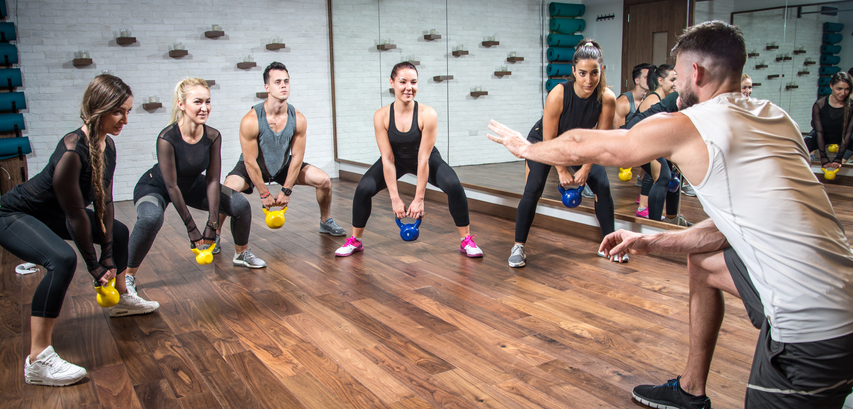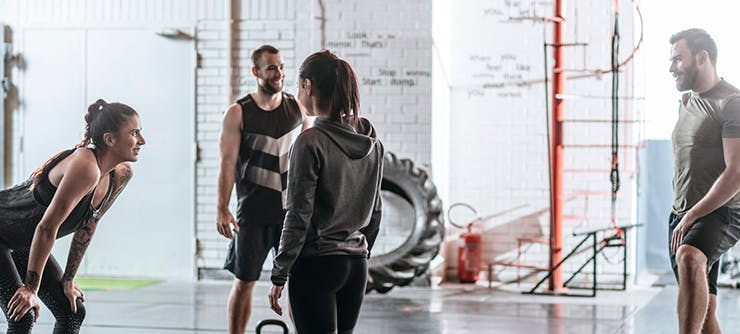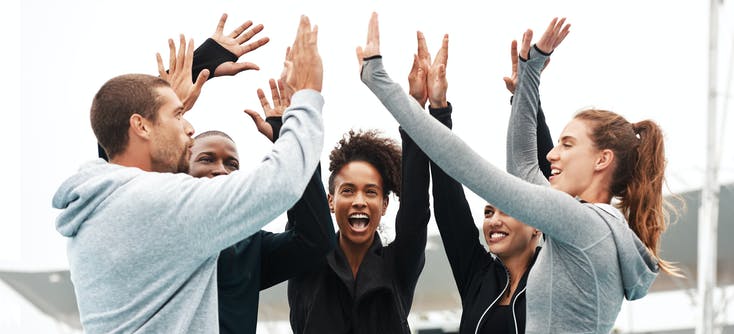Help your CrossFit customers achieve their goals of getting in shape by including the 11 best CrossFit exercises in your program and WOD. Designed to target key muscle groups, boost stamina and endurance, and build muscle, these exercises are perfect workout moves for everyone from new beginners to experienced athletes.
Learn each of their benefits and how to properly teach your customers how to perform each exercise. As an added bonus, some of our TeamUp CrossFit owners shared which are their favourites for their CrossFit box and why. Let's go.

1. Barbell Deadlift
One of the most popular foundational movements in CrossFit is the barbell deadlift. There are many benefits to barbell deadlifts including activating the hip extensors, reducing lower back pain, activating the core, and being an exercise that even beginners can quickly improve on.
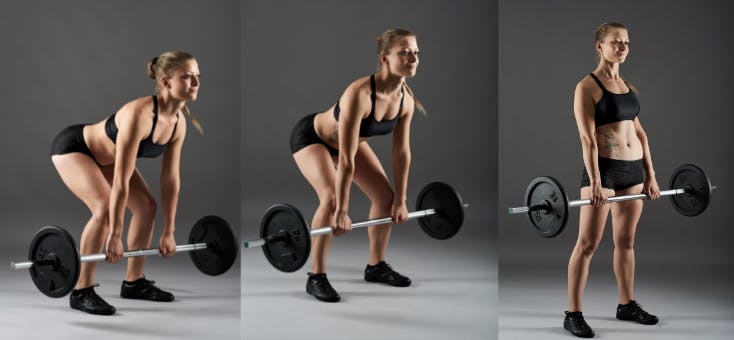
How to teach your clients how to do a barbell deadlift
Teaching a new CrossFitter how to do a barbell deadlift technique is quite simple, as it is one singular movement repeated:
- Instruct your athlete to stand firmly on the ground with their feet between hip and shoulder-width apart and with their arms extended grip the barbell with hands at a hip-width distance.
- To lift the bar up, they must bend in a quarter squat upwards keeping their arms extended without swaying the body or the bar.
- Once the bar is raised to hip length, they will return the bar to the floor and repeat.
An important tip is to drive through the heels and lift the chest as the bar lifts, taking away pressure from the knees. If the athlete swings the bar or their bodies as they rise, they are not doing the exercise correctly, and this can result in injury.
The deadlift is one of the most functional exercises there is, due to the fact that it's essentially what we do when we pick stuff off the ground. Done well, it increases overall strength including the elusive but so important grip strength, improves posture, increases power output (for sports mostly). For sure get an experienced professional to help with proper form, as it's easy to mess that up. - Roberto Morales, CrossFit Ville-Marie
2. Front Squat
The front squat technique differs from your average squat or air squat (another move we'll discuss in this guide). Targeting the lower body area, thighs, and glute muscles, this strength exercise includes a weighted barbell that is held in front of the body and maintained at shoulder height throughout the entire workout.
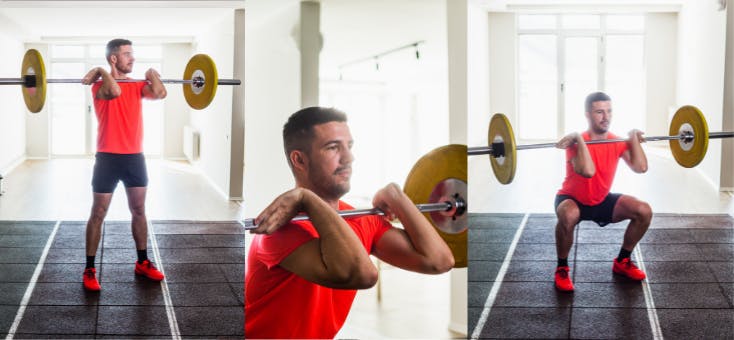
How to teach your clients how to do a front squat
To achieve the proper front squat form with a barbell, the athlete will usually start with a squat rack with the bar level at the middle of the chest before rising it to shoulder height.
- Holding the bar with both hands, wider than shoulder-width, the athlete will slowly drop into a squat position with feet also shoulder-width apart.
- Without letting the bar also move forward they will bring their elbows forward and as high up as possible with hands facing outwards.
- Once they are in a full squat position, the athlete will rise and repeat the squat movement for a certain number of sets, before returning the bar back onto the rack.
A good front squat technique to remember is to take full deep breaths and to keep the torso firm with heels driven down into the ground. In any squat, the knees should never go over the toes of the foot, and if the athlete is doing that they need to sit lower back into their heels.
The front squat, being a squat, is obviously another very functional exercise, mimicking a stand-up motion. The beauty of the front squat is that it can be done with any weight or even no weight at all. A broomstick is plenty to start and works the shoulder flexibility and stability, as well as leg and core strength. It's also the finishing position of a clean, the start of a thruster, a wall ball, etc. Overall a very complete movement. - Roberto Morales, CrossFit Ville-Marie
3. Box Jumps
Introducing the first plyometric exercise in this list, box jumps. Box jumps are fast and help athletes build their speed, agility and strength. Even when performed in a short amount of time, when the box jump technique is performed well it can make an athlete burn calories quickly and get a boost of cardio. A great addition for the best CrossFit exercise programs, box jumps primarily work and strengthen lower-body muscles including glutes, calves, hamstrings, and quads while giving the athlete a boost of cardio and increase stamina and endurance.
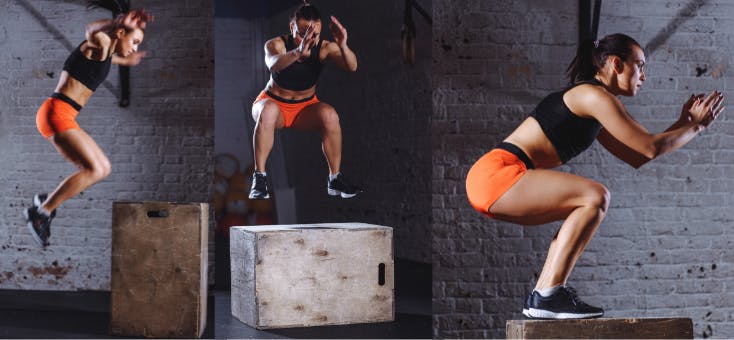
How to teach your clients how to do a box jump
To instruct your customers how to do a box jump they need to stand about a foot away from the box at its side. A recommended starting height is typically 50cm but this also depends on the height of the athlete.
- Standing feet shoulder-width apart, the athlete will need to bend their knees into a quarter squat while swinging the arms back to build momentum and explode off the ground and onto the top surface of the box.
- The ideal landing position is quarter squat form, rising into a full standing position. If the athlete lands in a deep squat, the box is too high.
- To repeat, jump down and start again on either side of the box. The faster performed, the more cardio burned.
4. Kettlebell swings
A fan favourite for CrossFitters who love abdominal exercises that don't require you to lay on the floor, kettlebell swings target almost every area of the body. When performed well kettlebell swings work the abs, pec, glute, and quad muscles, laterals, hips, hamstrings, and shoulders. New CrossFitters love how powerful kettlebell swings make them feel and how great of a workout they are for building both endurance and muscle strength.
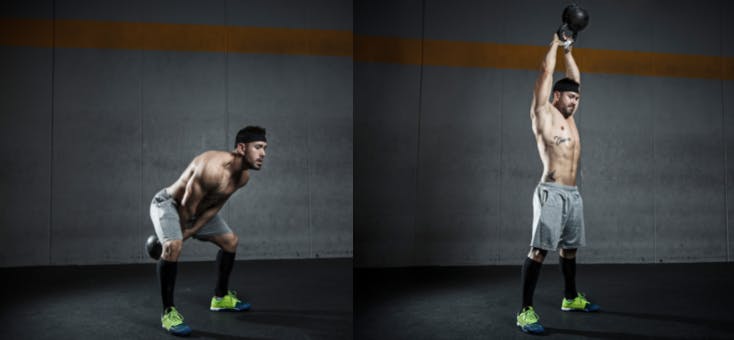
How to teach your clients how to do kettlebell swings as part of your CrossFit workouts
To properly perform a kettlebell swing workout, the athlete should do the following:
- Place the kettlebell in front of themselves and stand with their feet a little wider than shoulder-width, as if they were doing between a normal and sumo squat.
- They will then need to bend their knees to lean forward to collect the kettlebell to swing.
- Keeping their back flat, they'll then engage their legs to pull the kettlebell between their legs.
- Driving their hips forward to they will then pull the kettlebell through their legs forward.
- For a full workout, they will repeat this exercise.
Remember that for standard kettlebell swings during CrossFit Workouts, your kettlebell should never swing higher than shoulder height, and be careful not to send it too far behind you.
Coaches will always choose the squat. Back squats because they give members the most satisfaction! - Sue, CrossFit BattleBox
5. Wall balls
Get ready to make the lower body explode with wall balls. The benefits of wall balls as part of a WOD are numerous with the exercise targeting all the lower body muscles while also working the biceps, triceps, and shoulders for a complete full-body workout. Wall balls are a staple in CrossFit and a great way to get a burst of endurance while focusing on target muscle groups in several moves.

How to teach your clients how to do wall balls during CrossFit exercises
Known as a multi-part workout, wall balls can look easy, but be difficult when not performed correctly. New beginners to CrossFit exercises who are wondering what weight wall balls are best should use wall balls of 6 to 8 pounds to start. Advanced athletes will use 10 and above.
- Athletes performing this exercise start in a standing position about a foot away from a large wall.
- They will then lower down into a deep squat before exploding upwards to throw the ball up into the air along the wall.
- The athlete should keep the ball at chest height and bring it back down to their chest once the ball reaches back down to them.
- For a full workout, the athlete will repeat this movement several times as fast as possible without risking an injury.
6. Overhead Press
Another CrossFit favourite is the overhead press. An exercise that is excellent for building upper body strength, the overhead press targets the shoulders, chest, arms, and upper back. Beginners will start with little to no weight except for the bar, but as they scale up they will add more and more weight to intensify this workout.
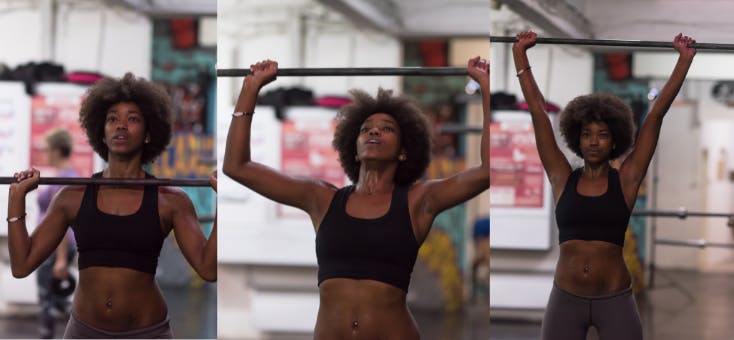
How to teach your clients how to do an overhead press
To teach your client the proper overhead press technique we recommend using a squat rack or light enough weight for your client to be able to and raise the barbell from the ground.
- Place the barbell (weighted or unweighted) at a level where your client can collect the bar at shoulder height.
- The athlete will then grip the bar with their hands slightly wider than shoulder-width apart.
- Once the bar is in position the athlete will then press the bar directly over their head and lower it down.
Instruct your clients to stand firm and not to swing their hips when they lift the bar.
Each person has their personal favourites but the squat is a fundamental movement in Crossfit that everyone should master unweighted first. - Brenda Dougan, CrossFit Fife
7. Thruster
If you have heard of CrossFit you have heard of thrusters. A well-known compound exercise that offers many benefits, thrusters are included in almost every CrossFit workout program and combine the two foundational moves of a front squat and an overhead press.
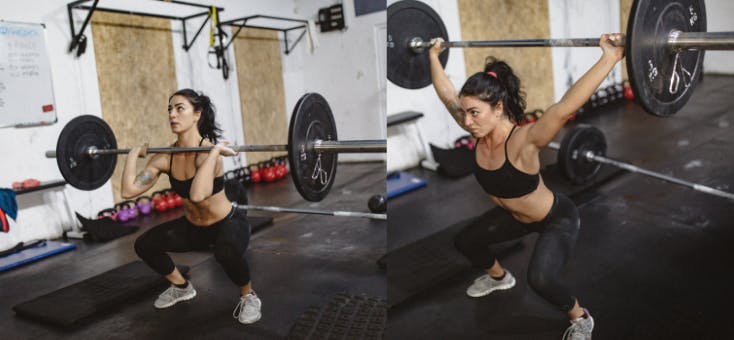
How to teach your client how to do a thruster
Thrusters combine two foundational CrossFit workouts, the front squat and the overhead press. To assist your clients with their thrusters technique they must first collect the weighted barbell from the squat rack.
- The athlete maintaining the same technique and form for a front squat.
- Rather than standing up and lowering back into a squat holding the barbell at shoulder height level, will thrust the weighted barbell over their head while rising to a stand.
- To lower back down they will lower the thruster carefully back to their chest and repeat.
Remember to instruct them to keep their arms bent at a 45-degree angle when in squat position and fully extended when thrusting.
Thrusters are on the CrossFit desert island disc list of barbell movements. If you could only do one movement for the rest of your life - the thruster would be it. Work on 1, 2 or 3 reps as heavy as you can go will get you strong! Go lighter and do as many as you can in three minutes, lighter, will have you flat on your back gasping for air. Great for abs - great for legs and bum - great for shoulders and back - what’s not to like? Take it from the floor every time and turn it into a cluster to make it just that bit more awful! - Kryzsia Stevens, CrossFit Uckfield
8. Handstand Pushup
An effective workout for athletes eager to give their shoulder muscles a burn, handstand pushups are ideal for strength and muscle building. Unlike your ordinary pushup, handstand pushups are performed on one's hands with their legs straight up towards the ceiling. This is not an easy CrossFit move and easily one of the most challenging for newcomers, but with a little bit of practice, dedicated athletes will quickly learn to appreciate the benefits this exercise provides them.

How to teach your clients how to do a handstand pushup
To perform a handstand push up, there are two options for a starter stance.
- One, the athlete can place their hands on the floor and use their momentum to lift themselves onto their hands.
- Or two, the athlete can place their hands alongside the floor about 10 to 20 cm from where it meets the wall, and thrust themselves upwards to land parallel with their heels, back, and shoulders touching the wall.
- Once in an upside-down position, to perform the handstand, the athlete must carefully bend their arms and into a 45-degree angle while slowly lowering themselves until their head touches the floor and then push themselves back up into a full arm extension.
- Repeat as needed.
For the best results, remember to instruct them to squeeze abs, glutes and thighs as tight as possible to keep the body firm.
9. Rope Climbs
For CrossFit athletes who really want to test their skills and strength, rope climbing is no easy challenge. This CrossFit exercise is a great way to strengthen grip and the upper body and build up biceps. Not only a physical exercise, but a mental one at that, rope climbing requires a lot of endurance and the ability to completely use one's own bodyweight to scale up the rope.
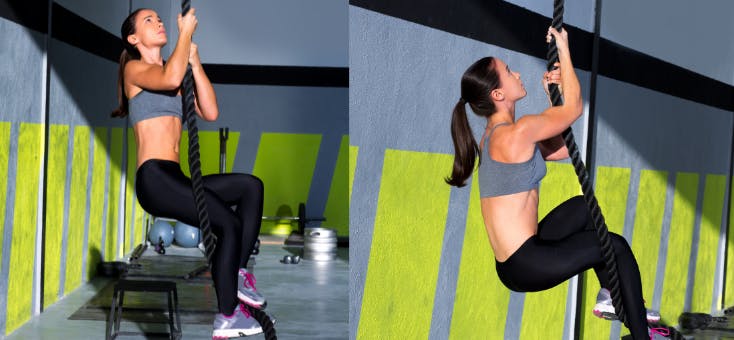
How to teach your clients how to do a rope climb
To program standard or legless rope climbs, first, your gym needs to have a sturdy rope properly and securely attached to the ceiling. You could also use a squat rack for your beginners.
- Instruct your athletes to lift off of one leg to then hoist themselves up onto the rope until both legs are on the rope.
- For the best rope climbing technique, the rope must be pinched between their feet, but for a legless rope climb, the athlete cannot use their feet.
- Using their arms to grip, they will extend each one up until they can grip hard enough to slide their feet up the rope with it still between the feet or using only their hands if it is a legless rope climb.
- They will repeat this movement until they have either reached the top.
Remember to instruct your athletes to keep their core tight.
10. Ring Muscle Up
Give your clients strength and cardio boost by teaching them how to do ring muscle-ups. This exercise is no easy feat and is one of the most challenging workouts in CrossFit, which makes it one of the most exciting to practice.

How to teach your clients how to do a ring muscle-up progression
Safety in this CrossFit exercise is key, and teaching your clients how to properly do a ring muscle-up with the right type of grip is essential.
- While hanging onto the rings (one in each hand) the athlete must hold them by doing a false grip with their fists closed.
- Next, they will pull themselves up towards the rings while keeping their elbows close to the body.
- Once they have pulled themselves up they will move into a push-up position (which is best to do when they have mastered the false grip) and lock into a sit-up position.
- To repeat they will lower themselves down and pull themselves up again as many times as the workout requires.
For CrossFit clients who need more practice with this exercise before moving to the rings, try using a resistance band and a rack with a bar to practice the pull-up movements.
For me, it's the ring muscle-up. It ticks so many boxes of the ten attributes of fitness...and it looks really cool. - Donald Beaton, CrossFit 57 North.
11. Overhead Squat
The overhead squat is one of the most basic CrossFit exercises, yet also the most important fundamental exercises in CrossFit. Nail the overhead squat technique and every other squat will be easier to learn, perform, and scale up. Often combined with other exercises, the overhead squat is a staple in any CrossFit program.
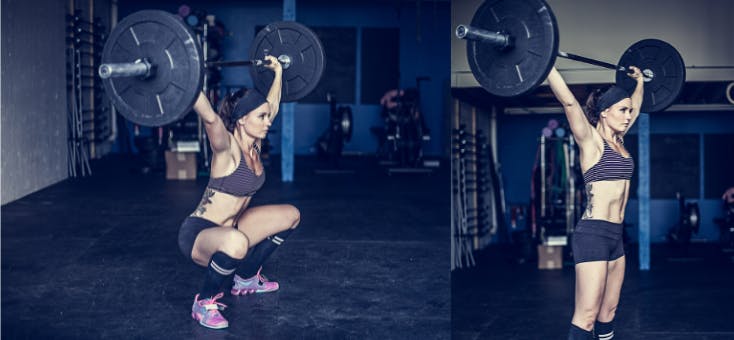
How to teach your clients to do an overhead squat
The proper overhead squat form is similar to that over a normal squat, only this time using a barbell or weighted barbell.
- Instruct the athlete to stand in a normal squat position, feet slightly more than hip-width apart with the barbell behind their neck at a wider than shoulder length grip.
- Next, they will push press or snatch the barbell upwards overhead while moving upwards into a full standing position.
- To repeat this exercise they will lower themselves back down into a squat position without lowering the bar.
Remind your athletes that their knees should not go over their toes to avoid injury.
Once we lose the ability to sit down and stand up we need to be cared for. A proficient Air Squat will keep up functionally independent. - Karl Learnihan, CrossFit All or Nothing
Best Crossfit Exercises To Increase Stamina
To break it down, if you want to focus on endurance in your programs, the best CrossFit exercises to increase stamina and endurance found in this list are:
- Box jumps
- Handstand pushup
- Ring muscle up
- Kettlebell swings
- Wall balls
- Air squats
Best CrossFit Workouts To Build Muscle
If you want to add more strength and muscle building exercises into your program, the best CrossFit workouts to build muscle are:
- Deadlifts
- Overhead thrusters
- Handstand pushups
- Wall balls
- Box jumps
- Kettlebell swings
- Front squat
- Overhead press
FAQs
Here are a few questions your new CrossFit customers might have for you at the start of their new journey.
Can beginners do the best CrossFit exercises?
Yes! The good news about each of these positions is that they can be performed with little or low weight to start. As an athlete improves and progresses, they will scale up and can add more weight.
How often should I do CrossFit a week?
While it's up to the athlete to decide how many Crossfit classes to attend a week, typically the official CrossFit body recommends attendance of 3-5 days a week, minimum being at least 3 days a week, with the maximum being 5 and never all in a row. Rest is essential in CrossFit and boxes usually require their athletes have at least one day a week of rest for the best recovery.
What are the 9 foundational movements of CrossFit?
According to the official CrossFit website, there are 9 foundational movements built into every exercise and workout program. They include:
- Push jerk
- Air squat
- Medicine ball clean
- Sumo deadlift high pull
- Deadlift
- Push press
- Shoulder press
- Overhead squat
These movements are designed to cover and optimise the fundamental areas of CrossFit which are cardio and respiratory endurance, strength, flexibility, stamina, power, speed, coordination, accuracy, balance, and agility.
To learn more about the best ways to run your CrossFit business, check out TeamUp's CrossFit management software and our guide on managing your affiliate and more common CrossFit FAQs.



